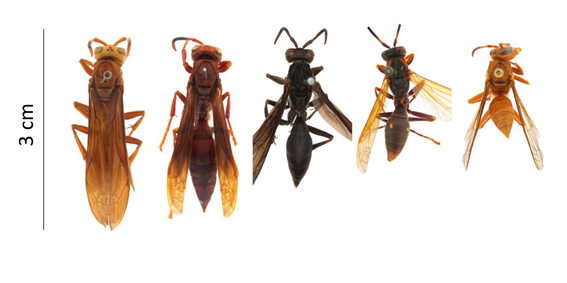

Variation in body size of paper wasps (Polistes) analyzed in the study. Each individual in the image represents a different species (photo: Alexandre Somavilla)
An analysis of 429 specimens belonging to 39 species representative of the diversity of Polistes in the Americas confirmed the inverse of Bergmann’s rule by pointing to larger body size for species occurring in or near the tropics compared with species inhabiting higher latitudes.
An analysis of 429 specimens belonging to 39 species representative of the diversity of Polistes in the Americas confirmed the inverse of Bergmann’s rule by pointing to larger body size for species occurring in or near the tropics compared with species inhabiting higher latitudes.

Variation in body size of paper wasps (Polistes) analyzed in the study. Each individual in the image represents a different species (photo: Alexandre Somavilla)
By André Julião | Agência FAPESP – A study of the correlation between environmental variables such as latitude and body size in paper wasps (genus Polistes) by a group of Brazilian researchers concludes that the nearer the habitat of a species to the equator, the larger its body size. The genus is widely distributed around the world and serves as a model for sociobiological and ecological studies.
An article on the study is published in the Biological Journal of the Linnean Society. The findings refute for these insects a nineteenth-century theory that predicts larger body size at higher latitudes or in colder regions of the planet.
“If you examine wasp collections worldwide, you notice that body size varies considerably from one species to another. We analyzed many specimens from a representative number of species and concluded that latitude is the key determinant of these differences,” said André Rodrigues de Souza, first author of the article and a researcher at the University of São Paulo’s Ribeirão Preto School of Philosophy, Science and Letters (FFCLRP-USP) with a Young Investigator Grant from FAPESP.
The researchers found that species living in warmer, less seasonal habitats closer to the equator tend to be larger than species living at higher latitudes, where temperatures are lower. This is the opposite of what is predicted by Bergmann’s rule.
Named for German biologist Carl Bergmann, who proposed it in 1847, the rule states that species with larger body sizes are found at high latitudes or in cold environments. A large body is an advantage for survival in a cold habitat: with less surface area in proportion to volume, they radiate less heat and can maintain a stable body temperature.
The article argues for the converse Bergmann’s rule, a twentieth-century theory proposed by scientists who observed that many ectothermic organisms inhabiting warmer regions tend to have larger body sizes than those in colder habitats. Ectotherms rely primarily on the external environment to regulate body temperature.
“A possible explanation for the converse Bergmann’s rule in this case is that at high latitudes and in more seasonal environments with low temperatures, the foraging period for wasps is very short and they become smaller adults as a result. Individuals that develop faster have an advantage, but at the cost of a smaller body size,” Souza said.
In temperate regions the favorable season for wasps lasts three to four months, while in the tropics it lasts about nine months, allowing more time for their young to forage and grow.
Collections
The researchers analyzed 429 well-preserved adult Polistes wasps belonging to species that occur throughout the Americas from Canada to Argentina. The specimens were sent to Brazil from museum collections in different countries or analyzed at the institutions holding the collections abroad. In all, 37 species were represented by females and 28 also by males; two were represented only by males, giving a total of 39 species investigated. The analysis included the use of statistical tools showing a direct correlation between latitude and body size.
Polistes species inhabiting the Americas were chosen because the phylogeny of this group on the continent is well-resolved: all species descend from the same ancestor, which is not known to be the case in other regions of the planet. Moreover, the diversity of the genus is greatest in the Americas, with around 90 species. The sample was therefore considered sufficient to validate the theory that body size is significantly influenced by environmental conditions.
A previous study by Souza and other collaborators showed that regulation of body temperature in paper wasps is not the main determinant of body size, as predicted by Bergmann’s rule. The authors conclude that darker insects have an advantage in colder environments because they can heat faster than lighter ones.
“Studies like these contribute to a broader picture of the evolution of paper wasps, helping us understand their diversity in tropical regions better and emphasizing the importance of conserving their habitats,” Souza said.
Furthermore, he added, the studies highlight the importance of preserving entomological collections, which provide material for ongoing research on the many species of paper wasps and the relationships among them.
The authors of the latest study also include researchers at the Federal University of the Minas Triangle (UFTM), the Federal University of Viçosa (UFV), and the National Institute of Amazon Research (INPA).
The article “Interspecific variation in paper wasp body size supports the converse Bergmann’s rule” is at: academic.oup.com/biolinnean/advance-article-abstract/doi/10.1093/biolinnean/blae074/7738264.
Republish
The Agency FAPESP licenses news via Creative Commons (CC-BY-NC-ND) so that they can be republished free of charge and in a simple way by other digital or printed vehicles. Agência FAPESP must be credited as the source of the content being republished and the name of the reporter (if any) must be attributed. Using the HMTL button below allows compliance with these rules, detailed in Digital Republishing Policy FAPESP.





